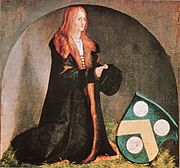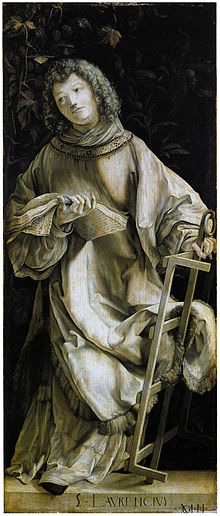Heller Altarpiece
| Heller Altarpiece | |
|---|---|
 | |
| Artist | Albrecht Dürer/Matthias Grünewald |
| Year | 1507-1509 |
| Medium | Oil on panel |
| Location | Städel,Frankfurt,andStaatliche Kunsthalle,Kalrsruhe. |
TheHeller Altarpiecewas anoil on paneltriptychby German Renaissance artistsAlbrecht DürerandMatthias Grünewald,executed between 1507 and 1509. The artwork was named afterJakob Heller,who ordered it. Dürer painted the interior, Grünewald the exterior.[1]
In 1615, DürercopyistJobst Harrichpainted a duplicate, which is now at theStädelofFrankfurt.[2]The side panels, executed by Dürer's workshop basing from his drawings, are at theStaatliche KunsthalleofKarlsruhe.
History[edit]
The painting was commissioned by Frankfurt merchant Jakob Heller, for theDominican churchof the city. In 1615, the central panel, the only one by Dürer alone, was sold toMaximilian I of Bavaria;a copy was ordered to replace the original in its location at the church's high altar. The central panel was destroyed by a fire in Munich in 1729. The famousdrawing of two praying handsin theAlbertinainViennais a study for one of the apostles in the central panel.


The side panels, executed by Dürer's assistants, were completed by other four commissioned to Matthias Grünewald in 1510. The side shutters were detached in the 18th century, and each of the two panels composing them were separated in 1804.
Description[edit]
The central panel, depicting theAssumptionandCoronationof the Virgin,was perhaps inspired byRaphael'sOddi Altarpiece.[3]It is not known if Dürer saw Raphael's work inPerugia,during a hypothetical trip to Rome after his stay inVenice,or if he knew it from etchings or drawings.
Mary is shown while the Holy Trinity (Jesus at right, the Eternal Father at the center and, at top, the Holy Spirit Dove) crowns her, surrounded by a multitude of cherubims; this iconography was popular in northern Europe art at the time, and was used, for example, in a panel byEnguerrand Quartonnow at theLouvre Museum(1454). Below, around the empty sepulcher, the apostles observe the scene in astonished postures. Dürer added a self-portrait in the background, next to a table with his signature and the date.
The internal side panels were painted by assistants from Dürer's drawings. At left is heMartyrdom of St. James;Jacob Heller appears below, kneeling inside a niche with his coat of arms. At right isMartyrdom of St. Catherine of Alexandria,with the donor's wife, Katharina von Melem. The choice of the saints was connected to the two donors' names.

The external panels were painted ingrisaille,with the participation of a young Matthias Grünewald.[4]They include eight depiction of saints; one, St. Lawrence, is signed "MGN". St. Cyriacus is portrayed during the exorcism of Artemia, daughter of Roman emperorDiocletian.He hold a book with the exorcism formula: ": AVCTORITATE DOMINI NOSTRI IHSVXPHISTI EXORCIZO TE PER ISTA TRIA NOMINA EDXAI EN ONOMATI GRAMMATON IN NOMINE PATRIS ET FILII ET SPIRITVS SANCTI AMEN".
See also[edit]
References[edit]
- ^The 100 Most Influential Painters and Sculptors of the Renaissance.Rosen Publishing Group. 2009. pp. 224–225.
- ^Kunstgeschichtliches Institut der Goethe-Universität Frankfurt am Main, DFG-Projekt »Sandrart.net«Heller-Altar, Kopie des Mittelbildes: Himmelfahrt Mariens. Retrieved 2010-05-30.
- ^Costantino Porcu, ed. (2004).Dürer.Milan: Rizzoli.
- ^Bryda, Gregory C. (2023). "Grünewald's Greenery in Spring and Summer".The Trees of the Cross: Wood as Subject and Medium in the Art of Late Medieval Germany.New Haven: Yale University Press. pp. 88–129.ISBN9780300267655.
Sources[edit]
- Costantino Porcu, ed. (2004).Dürer.Milan: Rizzoli.
Further reading[edit]
Rublack, Ulinka.Dürer's Lost Masterpiece: Art and Society at the Dawn of a Global World.Oxford University Press, 2023. ISBN 9780198873105

